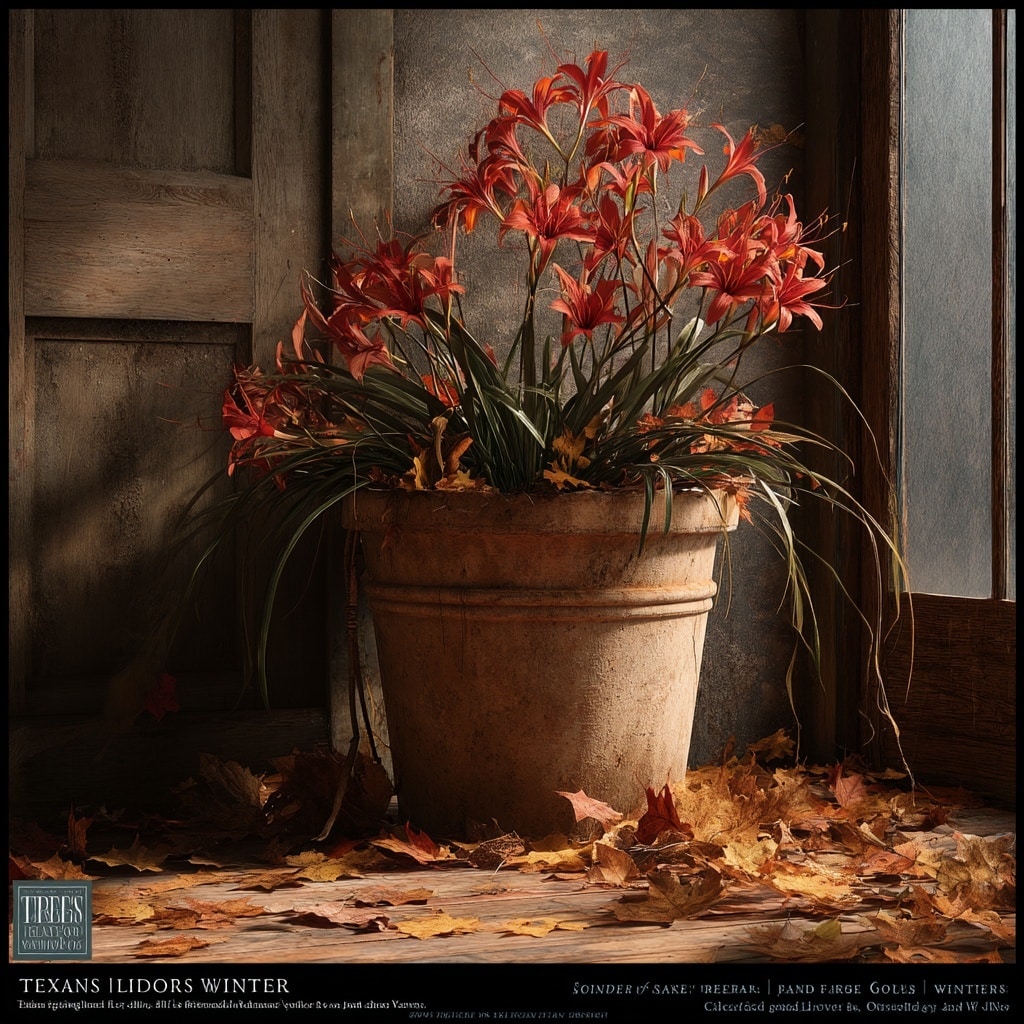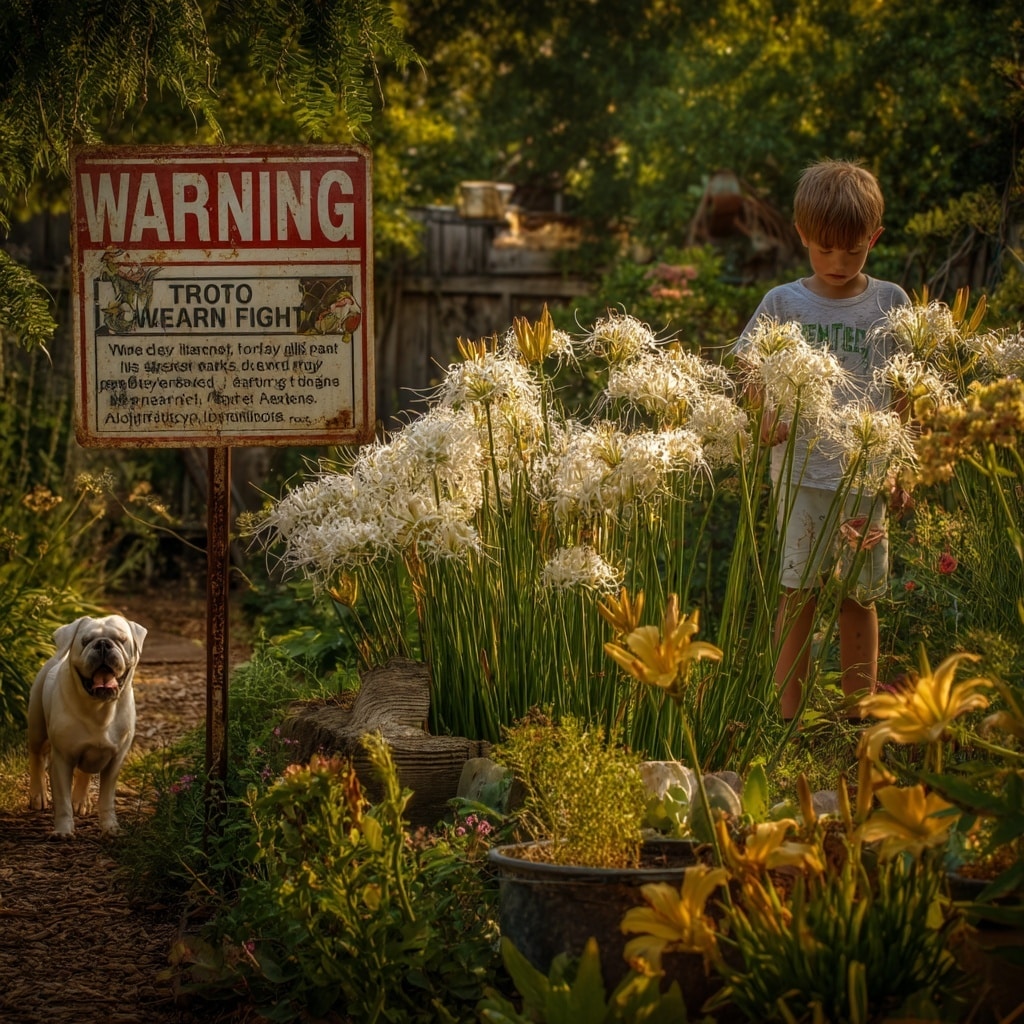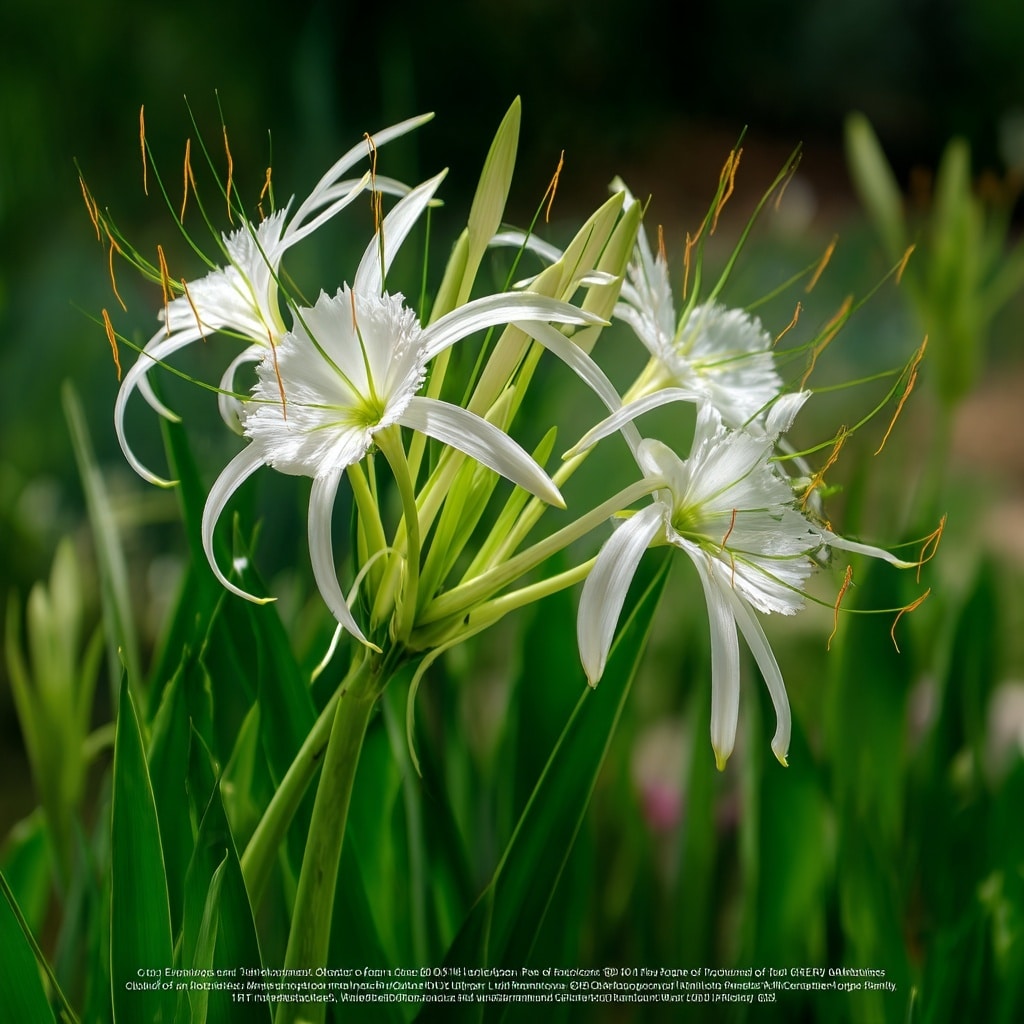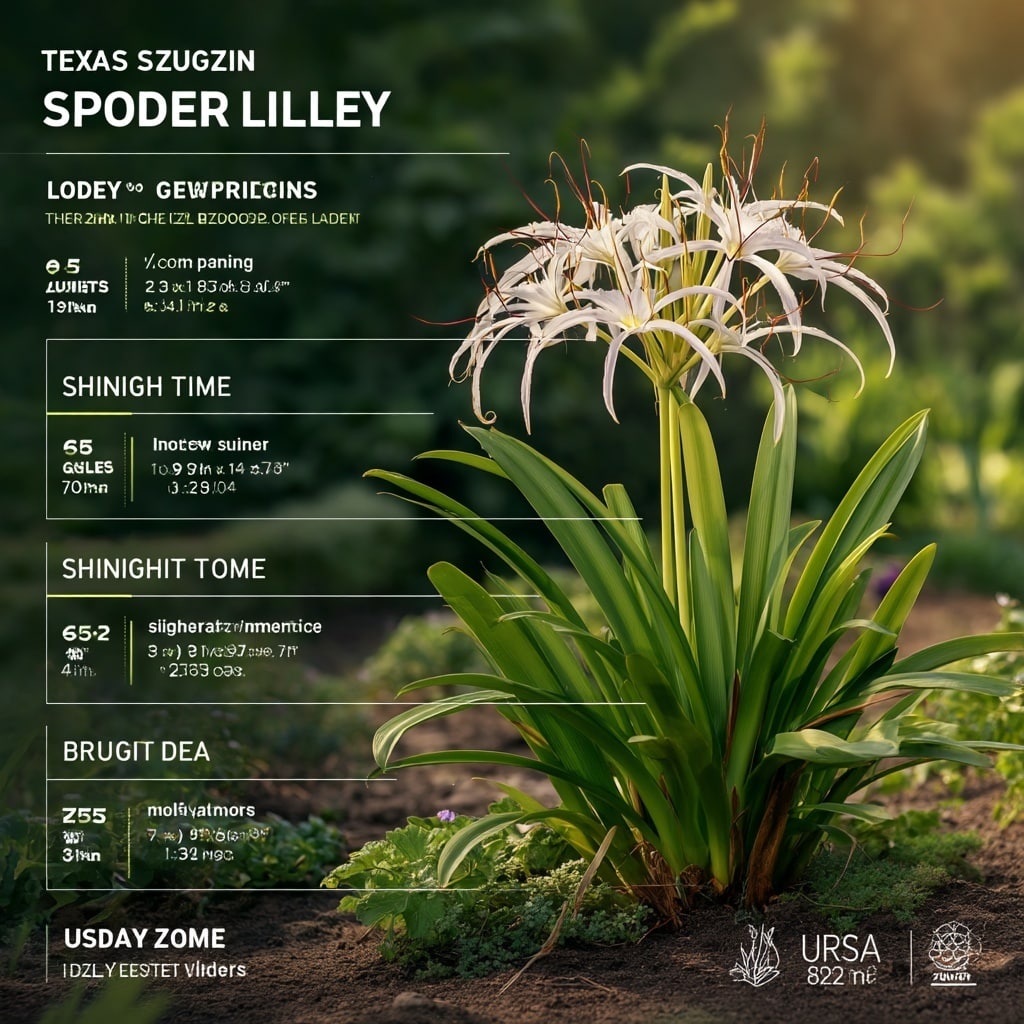Spider lily is a striking wetland perennial known for its fragrant white flowers, delicate petal structure, and ability to thrive in moist, sunny environments. Native to the southern United States, the Texas spider lily (Hymenocallis liriosme) adds both beauty and ecological value to pond edges, rain gardens, and low-lying landscapes. With its yellow-green floral “eye” and graceful form, it’s easy to see why gardeners are drawn to this plant—not only for its appearance but also for its role in supporting pollinators like butterflies, hummingbirds, and bees.
This guide will walk you through everything you need to know to successfully grow and care for spider lily—from selecting the right planting site to overwintering and preventing bulb rot. Whether you’re adding it to a garden bed or integrating it into your pond margins, you’ll learn the best practices to help it flourish.
Table of Contents
Texas Spider Lily Quick Facts & Growing Conditions
Growing spider lily successfully begins with understanding its natural preferences and environmental needs. Native to wetland habitats, this herbaceous perennial thrives in warm climates and moist soils, making it ideal for southern gardens and pond edges.
Quick Facts:
- Botanical Name: Hymenocallis liriosme
- Common Names: Texas spider lily, spring spider lily, western marsh spider lily
- Plant Type: Herbaceous perennial
- USDA Hardiness Zones: 8–10
- Light Needs: Full sun to partial shade
- Bloom Period: Mid-spring to early fall
- Height: 36–48 inches
- Spread: Up to 12 inches
- Planting Depth: Just deep enough to barely cover the bulb
Growth Habits:
Texas spider lily grows quickly from bulb to flower, typically reaching maturity within three to four months. It puts out sweet-scented, white blossoms that last for several months—an impressive bloom time stretching from May through October in most zones.
For best results, plant in full sun where possible, as more light generally leads to healthier foliage and increased flower production. That said, it will tolerate partial shade, especially in hotter regions, provided soil moisture is consistent.
This species is best suited to USDA zones 8 and warmer but can still be enjoyed in cooler climates if overwintered indoors.
How to Plant Texas Spider Lily (Especially in Pond Settings)

Planting spider lily bulbs correctly is essential for healthy growth and long-lasting blooms. Because this plant is adapted to wetlands and pond margins, it prefers consistently moist soil—but not saturated conditions—during its early stages of growth.
When to Plant
Early spring is the best time to plant spider lily bulbs, as soon as the danger of frost has passed. This gives the bulbs enough time to establish before the intense heat of summer or potential winter dormancy.
Bulb Planting Tips:
- Depth: Plant bulbs just deep enough so the top is slightly exposed or barely covered with soil.
- Spacing: Place bulbs at least 8–12 inches apart to allow adequate airflow and root expansion.
- Soil: Choose fertile, moisture-retentive, but well-draining soil. Heavy clay or constantly soggy soil can lead to bulb rot.
- Moisture: Keep soil evenly moist—never waterlogged—especially during early growth. Once the plant is established, it can tolerate short periods of standing water.
⚠️ Important: Do not plant bulbs directly in standing water until they are mature. Immature bulbs are prone to rotting if kept too wet.
Container Growing
If you live in a region with freezing winters, plant your spider lilies in large containers (around 3 gallons) to make overwintering easier. Containers should have drainage holes and be filled with rich, moist soil. These pots can be placed on pond shelves, garden beds, or patios during the growing season and moved indoors for winter protection.
Fertilizing
To encourage more blooms, apply a high-nitrogen fertilizer in early spring and mid-summer. If planting near a pond, use aquatic-safe fertilizer to avoid disrupting water quality.
Mulching & Moisture Retention
Add mulch around the base of each plant to help retain soil moisture and reduce how often you need to water. Organic mulch also helps regulate temperature around the bulbs.
Pruning & Flower Care
- Remove spent flowers promptly to promote new blooms.
- Avoid trimming back foliage until it has fully yellowed and wilted in the fall. Cutting too soon can rob the plant of stored energy needed for next year’s growth.
How to Overwinter Texas Spider Lily

Although spider lily thrives in warm, damp environments, it is not cold-hardy and requires special care in regions with frost or freezing temperatures. If you’re gardening in USDA zones lower than 8, you’ll need to protect your plants during winter to ensure their survival.
Cold Climate Tips:
- Container Advantage: The easiest method is to grow spider lily in pots. Before the first frost, move the containers indoors to a cool, dry, and frost-free area such as a garage, greenhouse, or enclosed porch.
- Indoor Storage Conditions: During dormancy, keep the soil barely moist or let it dry out completely if the bulbs have not sprouted. Avoid watering dormant bulbs—wet, inactive bulbs are extremely prone to rot.
- No Indoor Heat Needed: These bulbs don’t require warmth during winter rest, just protection from freezing temperatures.
Outdoor Wintering (Zone 8+):
If you’re in a mild climate where the ground doesn’t freeze, you can leave spider lilies in the ground year-round. However, applying a thick layer of mulch (2–3 inches) in late fall will help insulate the bulbs and stabilize soil moisture.
Is Spider Lily Toxic, Poisonous, or Invasive?

Although spider lily is a stunning addition to wetland gardens, it’s important to understand its potential risks and ecological impact—especially if you have pets, children, or aquatic life nearby.
Toxicity Warning:
All parts of the Texas spider lily—leaves, stems, bulbs, and flowers—contain lycorine, a toxic alkaloid. If ingested, it can cause symptoms such as:
- Vomiting
- Diarrhea
- Abdominal pain
- In severe cases, convulsions
This toxicity applies to humans, dogs, cats, and livestock. While the plant isn’t likely to tempt fish, always remove fallen leaves or trimmings from your pond to prevent decay and maintain water quality.
⚠️ Pro Tip: Wear gloves when handling bulbs or pruning the plant, and keep children and pets away from planting areas.
Is It Invasive?
The Texas spider lily (Hymenocallis liriosme) is native to the southern U.S., particularly in wetland zones of Texas and nearby states. It is not considered invasive in its native range and spreads slowly. However, if you’re planting outside of its natural habitat, take care not to introduce it into wild ecosystems.
While other varieties, like the red spider lily (Lycoris radiata), have shown invasive tendencies in some areas, Hymenocallis liriosme is generally safe for contained garden and pond environments.
Is Texas Spider Lily Edible? Will Fish Eat It?

Spider lily may look delicate and inviting, but it is absolutely not edible—for humans or animals. Every part of Hymenocallis liriosme contains toxic compounds, particularly the bulb and sap, which can cause serious health issues if consumed.
Edibility:
- Not edible for humans – Can cause nausea, vomiting, and other digestive distress if ingested.
- Not safe for pets or livestock – Keep dogs, cats, and grazing animals away from planting sites.
Fish and Aquatic Life:
If you’re growing spider lily near or in your pond, you’ll be relieved to know that most fish will ignore the plant entirely. The bitter taste and toxic compounds naturally deter aquatic species from nibbling on its foliage or roots.
However, you should still:
- Regularly remove dead or trimmed leaves from the water.
- Monitor plant debris to prevent decay that could affect pond water quality.
Where to Buy Texas Spider Lily & Seeds (Tips for Sourcing the Right Species)
When searching for spider lily plants or bulbs, it’s important to ensure you’re getting the correct species—Hymenocallis liriosme—and not a more aggressive or non-native variety.
What to Look For:
- Botanical Name Matters: Always verify the scientific name (Hymenocallis liriosme) before purchasing. Many retailers list “spider lily” without specifying the species, which can lead to confusion.
- Avoid Red Spider Lily Mix-ups: The red spider lily (Lycoris radiata), while beautiful, is native to East Asia and has a higher potential for invasive spread. It also differs in its seasonal behavior and growth habits.
Where to Shop:
- Local Nurseries: Check native plant or aquatic plant nurseries in southern U.S. states for region-appropriate stock.
- Online Retailers: There are reputable online shops that specialize in pond plants or southern natives. Look for vendors that list full plant details and USDA zone suitability.
- Pond Supply Stores: Retailers that cater to pond and aquatic gardens often carry spider lilies suited for water margins or shallow pond areas.
Seasonal Availability:
Spider lily bulbs are typically available in early spring and sometimes again in fall. Ordering ahead can help ensure availability, especially for rarer native species.
Conclusion
Spider lily is a graceful, low-maintenance perennial that brings striking beauty and ecological value to any water garden or moist landscape. With its long blooming season, ability to support pollinators, and resilience in warm climates, Hymenocallis liriosme is a rewarding choice for gardeners looking to enhance pond margins, ditches, or rain gardens.
By following proper planting methods, managing moisture carefully, and protecting the bulbs from cold and rot, you’ll enjoy seasons of elegant white blooms and minimal upkeep. Just be mindful of its toxicity, and always choose the right species for your growing zone.
Whether you’re planting directly into moist soil or using containers, spider lily has a place in both beginner and expert gardens alike.


